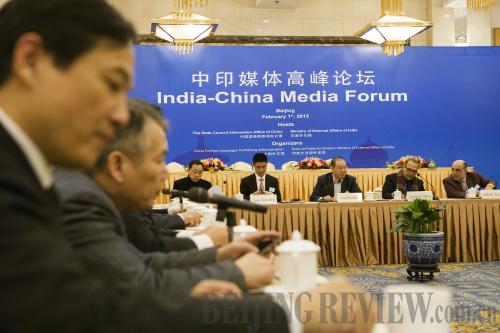|
 |
|
CLASH OF IDEAS: Chinese and Indian panelists at the Second China-India Media Forum share their views on media relations between the two countries on February 1 (WANG XIANG) |
China and India are not only neighbors but also important rising economies and global powers with a combined population accounting for 35 percent of the world's total. However, the two nations remain largely distant in some respects. A survey about the rise of China conducted in India in 2013 by the Asian Barometer Survey Organization showed that many Indians lacked knowledge about the growing power to their north. And in recent interviews with Beijing Review, most Chinese respondents expressed stereotypes about India that focused on negative qualities like poor infrastructure and social governance, overlooking India's status as a global leader in information technology and the bio-pharmaceutical industry.
Media observers said a lack of mutual understanding is the root cause of the indifference and even outright ignorance displayed by the peoples of the two countries toward each other.
China-India relations have entered a period of overall accelerated growth. Nonetheless, persistently negative media reports of the two sides are failing to improve the relationship. Some in the media overhype border disputes and political issues while neglecting bilateral economic cooperation and people-to-people exchanges.
At the Second China-India Media Forum on February 1 in Beijing, a platform jointly established by the State Council Information Office of China and the Ministry of External Affairs (MEA) of India to enhance bilateral media exchanges, participants from the mainstream media outlets of both countries addressed these issues. These media representatives held candid and in-depth exchanges on the crux of the problems and the convergence of their interests to provide the general public of both countries with accurate and comprehensive information in order to reduce misunderstandings.
The crux
Most participants of the forum noted that one of the major reasons for the isolation felt by the two sides toward one another is the narrow scope of reporting carried out by either party on the other's country.
Liu Cong, Executive Director of China Central Television News English Channel, said that as the two most important forces in the global multipolarization process, China and India share much common ground. However, she noted, apart from visits and meetings between leaders of the two countries, border disputes comprise the mostly highly covered topics regarding the pair. This narrow focus limits people's knowledge of each other and results in misunderstanding, skepticism and even prejudice, she said.
Swapan Dasgupta, an Indian media veteran with experience working for outlets including The Times of India and most recently India Today, shared a similar view, claiming that most China-related stories are limited to political issues, while cultural topics were underreported.
Manish Chand, Editor in Chief of India Writes, echoed Dasgupta's view by noting that Indian media should break the tradition of always "looking at China-India relations through the security prism," and devote more energy to culture stories.
"Culture is always a missing component in Indian media coverage. The frame of reference while thinking of culture is mostly the West. We speak of Hollywood and its films and actors, but how many people know of Chinese films and directors?" said Chand.
Li Yafang, President of Beijing Review, said that in addition to reports on political and economic events, more stories should show how bilateral relations affect the lives and hearts of average people.
"We should neither intentionally avoid reports on disputes nor neglect bilateral consensus. As media, we should report the facts while giving rational proposals to settle disputes," said Li.
Regarding sensationalism in the media, participants from both sides admitted that the heavy focus on negative stories and disputes stems from the nature of
journalism—recalling the industry phrase, "If it bleeds, it leads."
However, Gao Anming, Deputy Editor in Chief of China Daily, called for media from both countries to attach more importance to their social responsibilities.
Gao said that as an important channel for peoples of different nations to understand one another, it is necessary for the media to strictly observe professional integrity and avoid irrational nationalism.
Dasgupta also stressed that although media cannot change history, it can influence how history is interpreted today.
Representatives from both sides agreed that the reporting of each other's country were deeply influenced by Western media.
| 